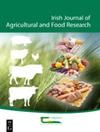使用简单的生长发育模型评估爱尔兰空间对比地区的水分限制冬小麦产量潜力
IF 1.4
4区 农林科学
Q3 AGRICULTURE, MULTIDISCIPLINARY
引用次数: 3
摘要
摘要尽管爱尔兰冬小麦产量是全球最高的,但要保持其经济可行性,就需要提高这种作物的盈利能力。然而,为了确定进一步提高爱尔兰小麦产量的努力是否可能成功,需要准确估计爱尔兰不同地区的产量潜力。开发了一个冬小麦产量潜力模型(WWYPM),该模型估计了在当前遗传资源和技术范围内可实现的最大限水产量,使用最近在爱尔兰观测到的冬小麦生长发育参数和少量的每日气象输入(最高和最低日温度、总日降雨量和总日入射辐射)。WWYPM由三个过程组成:(i)潜在绿地指数的估计,(ii)光截获和生物量积累的估计,以及(iii)生物量分配对粮食产量的估计。模型验证表明,WWYPM对水分限制产量潜力(YPw)的估计与品种评估试验中记录的最大产量以及区域平均和最大农场产量显著相关,反映了该模型对气候环境随空间和季节变化的变化的敏感性。对位于爱尔兰空间对比区域的12个地点的长期平均天气数据的YPw模拟表明,典型的YPw在15.6至17.9 t/ha之间变化,在含水量为15%时,平均值为16.7 t/ha。这些结果表明,如果不考虑非常高的降雨量和其他压力(如疾病发生率和营养缺乏)的影响,爱尔兰的大多数地区都有潜力种植高产的冬小麦作物。本文章由计算机程序翻译,如有差异,请以英文原文为准。
Assessment of water-limited winter wheat yield potential at spatially contrasting sites in Ireland using a simple growth and development model
Abstract Although Irish winter wheat yields are among the highest globally, increases in the profitability of this crop are required to maintain its economic viability. However, in order to determine if efforts to further increase Irish wheat yields are likely to be successful, an accurate estimation of the yield potential is required for different regions within Ireland. A winter wheat yield potential model (WWYPM) was developed, which estimates the maximum water-limited yield achievable, within the confines of current genetic resources and technologies, using parameters for winter wheat growth and development observed recently in Ireland and a minor amount of daily meteorological input (maximum and minimum daily temperature, total daily rainfall and total daily incident radiation). The WWYPM is composed of three processes: (i) an estimation of potential green area index, (ii) an estimation of light interception and biomass accumulation and (iii) an estimation of biomass partitioning to grain yield. Model validation indicated that WWYPM estimations of water-limited yield potential (YPw) were significantly related to maximum yields recorded in variety evaluation trials as well as regional average and maximum farm yields, reflecting the model’s sensitivity to alterations in the climatic environment with spatial and seasonal variations. Simulations of YPw for long-term average weather data at 12 sites located at spatially contrasting regions of Ireland indicated that the typical YPw varied between 15.6 and 17.9 t/ha, with a mean of 16.7 t/ha at 15% moisture content. These results indicate that the majority of sites in Ireland have the potential to grow high-yielding crops of winter wheat when the effects of very high rainfall and other stresses such as disease incidence and nutrient deficits are not considered.
求助全文
通过发布文献求助,成功后即可免费获取论文全文。
去求助
来源期刊
CiteScore
2.50
自引率
20.00%
发文量
23
审稿时长
>36 weeks
期刊介绍:
The Irish Journal of Agricultural and Food Research is a peer reviewed open access scientific journal published by Teagasc (Agriculture and Food Development Authority, Ireland). Manuscripts on any aspect of research of direct relevance to Irish agriculture and food production, including plant and animal sciences, food science, agri environmental science, soils, engineering, buildings, economics and sociology, will be considered for publication. The work must demonstrate novelty and relevance to the field of research. Papers published or offered for publication elsewhere will not be considered, but the publication of an abstract does not preclude the publication of the full paper in this journal.

 求助内容:
求助内容: 应助结果提醒方式:
应助结果提醒方式:


